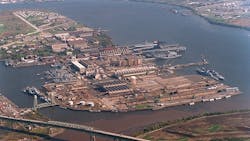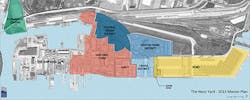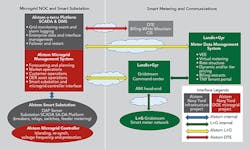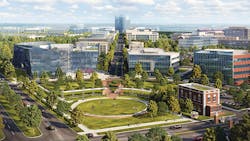While there is plenty of talk about the potential microgrid value proposition, only a few locations exist where microgrid development is actually underway, especially where the business partner is leading the charge. One of these locations is The Navy Yard in Philadelphia, Pennsylvania, U.S., where a robust microgrid development is occurring and will be operational in 2016.
Under the leadership of PIDC, Philadelphia’s public-private economic development corporation, this microgrid and grid modernization project is being developed as an integral part of the overall 1,200-acre (486-hectare) property redevelopment. The Navy Yard is a former naval shipyard that has been revitalized as a dynamic and progressive business campus, and serves as one of the Philadelphia region’s most significant economic development projects. One reason for The Navy Yard’s success is PIDC has adopted sustainability and progressive energy planning and implementation as a cornerstone of the entire development.
At the onset of the microgrid project, PIDC and its energy team established the following set of guiding principles that makes this significant on a national level and within the embryonic microgrid marketplace:
- All investment decisions are being made based on the business proposition.
- Particular focus is on developing a platform of foundational services that will be used to engage The Navy Yard businesses to achieve increased scalability.
- Industry engagement and partnership collaboration is essential. An example of success is Alstom Grid’s decision in June 2015 to establish its North American MicroGrid Center of Excellence at The Navy Yard.
- Strong coordination by PIDC and its energy team must occur with PECO and PJM to pursue solutions that appeal to both the utility industry and the microgrid owner.
- While microgrid choices are being made based on the economics, PIDC is committed to continuing to position The Navy Yard’s unregulated grid for academic, U.S. Department of Energy (DOE) and industry-led research, development and educational activities.
The Navy Yard
The Navy Yard is a modern and dynamic urban development, offering the Philadelphia region a unique and centrally located waterfront business campus committed to smart growth, energy innovation and sustainability. Since the U.S. Navy closed the historic Philadelphia Naval Shipyard complex in the 1990s, The Navy Yard has re-emerged as a magnet for new businesses, employment and investment in Philadelphia. It currently houses more than 150 companies that employ more than 11,500 workers.
PIDC is the master developer at The Navy Yard, managing all aspects of the property’s development, and PAID is the authority through which PIDC manages The Navy Yard on behalf of the city of Philadelphia.
PAID owns and has operating responsibility for the electric distribution system serving The Navy Yard. This distribution system is one of the largest unregulated nonmilitary grids on the Eastern seaboard of the U.S. Peak demand is 28 MW and annual usage is about 152 million kWh. Not all of the 150 businesses are electric customers; rather, The Navy Yard electric utility serves 70 customer accounts and bills these customers by way of 188 revenue-grade meters. The customers include a U.S. leading commercial shipbuilder; the 14-building headquarters for a global retailer; several U.S. Navy manufacturing, engineering and research facilities; a world-class, large-scale LEED bakery; and numerous multi-tenant office buildings.
Energy Master Plan
In early 2013, PIDC released the comprehensive Navy Yard Energy Master Plan (NYEMP), which intentionally coincided with the real estate master plan update. These two plans in tandem evidenced that long-term energy strategy and implementation would have to be included with the traditional real estate and economic activity planning of the past. The purpose of the NYEMP was to determine the most cost-effective strategy for realizing long-term growing electric capacity needs for The Navy Yard, with a new model — not necessarily business as usual.
According to the NYEMP, growth in electricity consumption could reach more than 300 million kWh by 2022, requiring 60 MW of capacity. The NYEMP concluded a strong business case exists to provide new on-site generation and storage capacities in combination with rigorous energy-efficiency measures, thereby both reducing and flattening the overall load curve of The Navy Yard.
Within the 10-year NYEMP, PIDC projects adding approximately 10 MW of major on-site generation and storage capacity, including renewable and high-efficiency options; providing a new 10-MW primary substation fed from a third diverse source in the PECO service territory; and completely modernizing operations with the latest proven digital monitoring, control and communications technology.
The Navy Yard Energy Team
PIDC understood one of the most important steps prior to developing the NYEMP would be to assemble a world-class team of energy and energy-efficiency collaborators to pursue a new energy solution. To start, request for proposals (RFPs) leading to the NYEMP asked respondents to consider forming teams that would represent a variety of expertise, with the winning team of 16 respondents being led by Alsom Grid, Utility Integration Solutions (UISOL) and the Burns Group, a local energy and engineering firm. Several other firms have been engaged at different parts in the overall process, including Mondre Energy, ICF International, Viridity Energy, Dynamic Energy Group and The Pennsylvania State University.
“Alstom Grid realized what a great opportunity existed in getting involved at The Navy Yard, particularly because of the approach that PIDC led with the RFP,” explained Jayant Kumar, Alstom’s global director of smart grid programs. “We thought that this could be a tremendous opportunity to demonstrate how to go about solving problems that are so common with an older electrical infrastructure that exists in so many communities like The Navy Yard, and appreciated the opportunity to work with local partners, like the Burns Group, that would be helpful in understanding the local code and permit requirements.”
The energy team also realized the importance of including the existing services provider to The Navy Yard electric grid, DTE Energy, as it came closer to choosing some of the technology solutions. For example, DTE had considerable input when the team chose Landis+Gyr to provide smart meters and the communications and network operations center (NOC) infrastructure. Now these two firms are working closely to implement the installation and start up the program.
Grid Modernization Underway
PIDC and the energy team are currently implementing a US$33 million comprehensive implementation plan with the following foundational components:
- Advanced metering infrastructure, which includes Landis+Gyr single-phase and three-phase smart meters with integrated wireless mesh radio-frequency transmitters and the L+G Gridstream head-end computer system
- Communications, which consists of the L+G Gridstream wireless mesh self-healing radio-frequency network for The Navy Yard campus along with the AT&T backhaul wide-area network to the L+G data center
- Smart substation, which includes Alstom MiCOM feeder management and protection intelligent electronic devices, and DAP server (device integrator and data concentrator) with Ethernet communication support
- Microgrid NOC, which is an Alstom Microgrid NOC for grid monitoring and operations in grid-connected and islanded modes of operation, integrated with a smart substation and advanced microgrid controller.
Open architecture provides the foundational grid modernization technology that will support numerous future applications, providing additional energy choice, energy efficiency and flexibility. Having won a DOE award in late 2014, Alstom also is working with PECO and PIDC to provide thought leadership on the Utility 2.0, particularly concerning the micro-grid controller. PJM will work closely with The Navy Yard and the Alstom DOE Office of Electricity team to develop understanding of the consumption and generation behavior of microgrids, so the microgrid can become a better resource incorporating load forecasting, resource adequacy planning and market design for providing reliability and resiliency services to the bulk power system.
In addition, several major distributed energy resource projects will be in service by the end of 2016:
- A new 6-MW natural gas peak-shaving generator designed to provide the future ability of islanding and 99% resilience, along with the ongoing dramatic reduction of peak load costs and participation in the PJM ancillary revenue market
- A 750-kW community solar generator, developed by a private-sector owner and operator
- A 1-MW grid-scale energy storage battery farm, owned and operated by Sun Edison, that will provide ancillary and demand-response services for the PJM regional energy market
- A new substation providing an additional 10 MW (expandable to 15 MW) of power from PECO.
While so much has already been accomplished, The Navy Yard’s energy team believes the future is even more exciting. PIDC already is planning for the next phase of its microgrid development by thinking about its future in connection with the successes of its development to date.
Future Needs
Addressing the existing and future needs of The Navy Yard customer is the most important driver behind PIDC’s grid modernization program. This means the energy team will continue to work to analyze, plan and implement programs to address these factors most important to the electric customer:
- Resilience and reliability of service
- Cost of electricity and overall energy expense
- Corporate alternative energy and sustainability in action.
Coordination with PJM and PECO
The PJM system is internationally regarded as one of the most market-advanced independent system operators. Being able to develop plans for energy procurement within this marketplace sets The Navy Yard apart. PECO, as a part of Exelon, which owns several transmission and distribution networks, is also deeply committed to innovation.
As the microgrid proposition evolves, it will be critical for The Navy Yard to continue its partnership with PECO to coordinate learning and activities regarding interconnection, islanding action and sequencing plans, and better demand-response tactics, just to name a few.
“Our collaboration with The Navy Yard microgrid project is critical to advancing innovative technologies that promote smart energy solutions,” said Liz Murphy, PECO’s vice president of governmental and external affairs. “We continue to provide our expertise and support to ensure a coordinated partnership and connection between utilities and microgrids to deliver safe, reliable and affordable service to meet the evolving energy needs of our customers. PECO remains on the leading edge of this technology, and this work provides fundamental insight to support innovative projects throughout our region.”
Refining the Business Case
As PIDC and its energy team completes integration and cut-overs of the grid modernization project in early 2016, the next exciting stage of automated operations and data flow will commence. At the same time, a program to engage the businesses at The Navy Yard will be underway, so a broader base of customer activities will also emerge.
The MicroGrid NOC will begin to serve as a tool to process revenue and expense inputs, and the team will be able to start analyzing the financial performance of the various energy initiatives for The Navy Yard. As with any new set of initiatives, comparing the reality of these new operations to the pro forma developed while under design is always important so future projects can be better understood and ongoing operations further refined.
Additionally, to continue to modernize and expand The Navy Yard’s integrated energy program, PIDC will be creating a new third-party partnership for an operations and maintenance contract that will commence in early 2017 with a RFP coming out later this year. This decision is evidence of PIDC’s commitment to the next phase of development of the microgrid, by recognizing the importance of adding more expertise and resources to reach the full potential of The Navy Yard.
The Navy Yard microgrid project should provide significant economic value to all parties involved. For the owner of The Navy Yard and the electric utility, new forms of revenue from the PJM marketplace and system energy efficiencies will occur. These efficiencies will have the effect of driving down The Navy Yard’s electric costs and therefore customer rates. The project will enable the customer to deploy its own alternative energy generation and storage projects. Finally, this will all result in the energy and utility industries being able to learn from the projects being deployed on the commercial scale of The Navy Yard, which promises to keep The Navy Yard active in deploying microgrid solutions for many years to come as a national demonstration center.
Acknowledgment
Dr. Jayant Kumar, the global director of smart grid programs at Alstom Grid, and Bob Uluski, vice president and executive consultant at UISOL, are key participants in this project and contributors to this article.
Will Agate ([email protected]) is senior vice president of The Navy Yard energy operations and initiatives at PIDC, Philadelphia’s public-private economic development corporation. Since joining PIDC in 2010, Agate has led the management and development of The Navy Yard and in developing the NYEMP. Recently, he has shifted his entire focus to energy responsibilities that include oversight of The Navy Yard’s unregulated grid and the grid modernization project currently underway. He is an avid proponent of incorporating progressive sustainability practices as a core principle driving development and serves on multiple civic boards in the Greater Philadelphia area.



